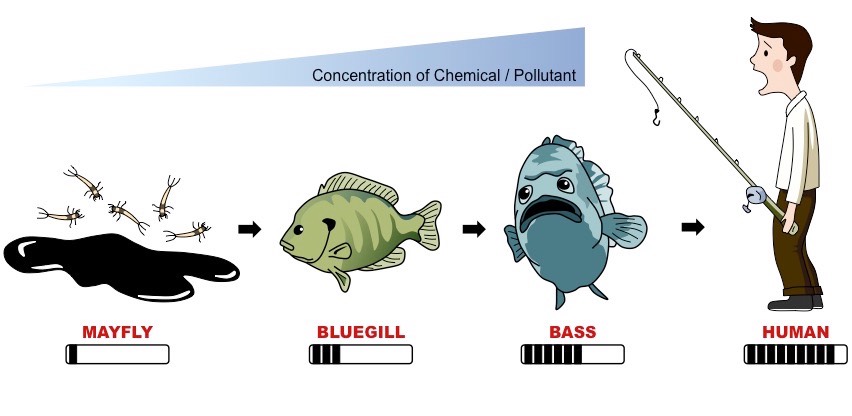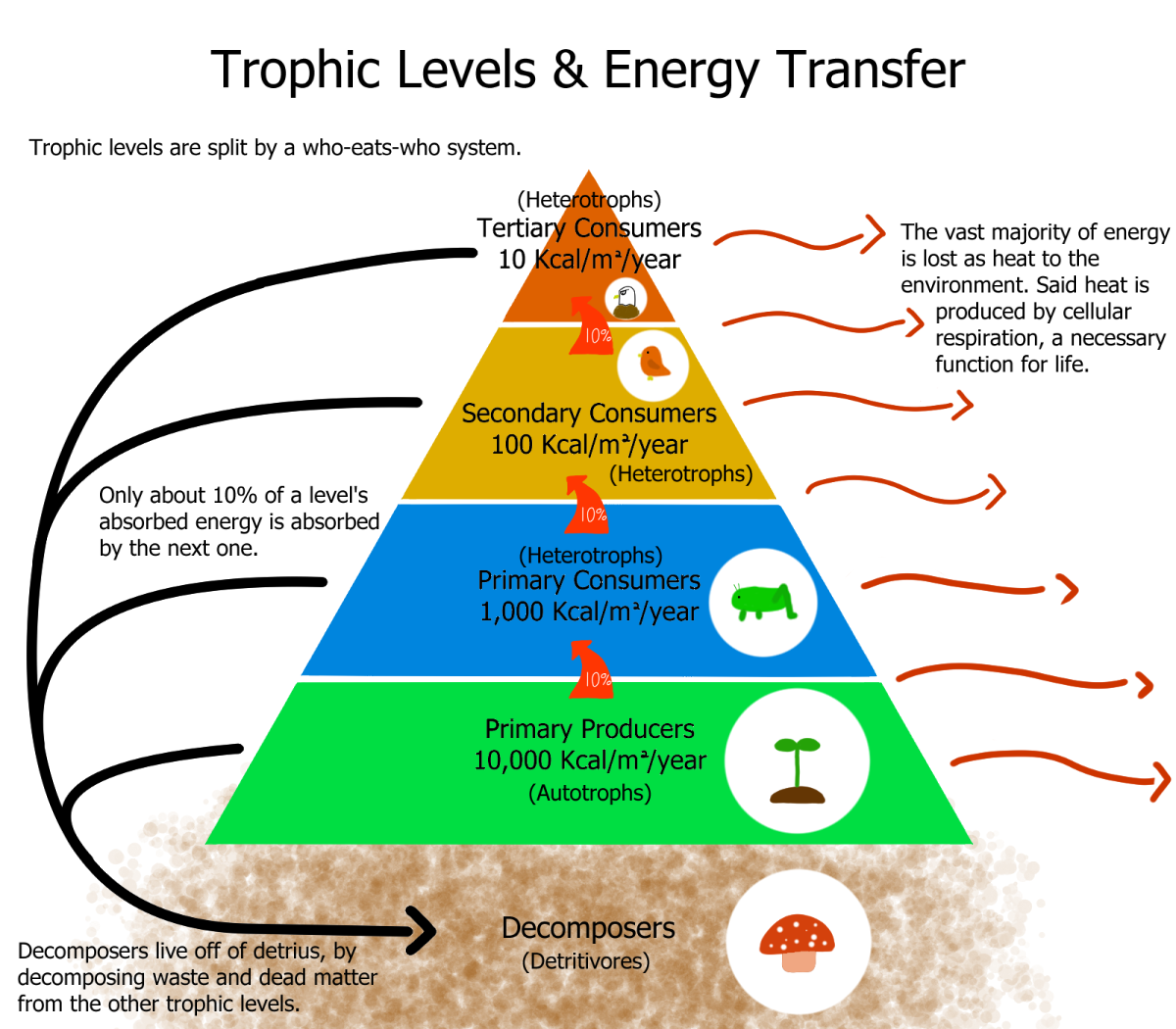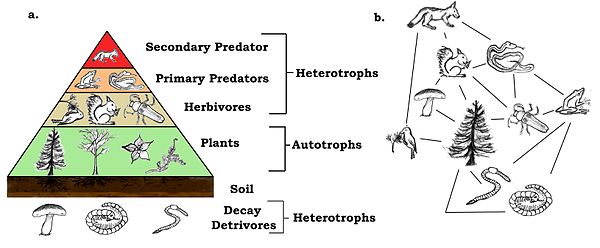Energy is critical for the survival of life on Earth, as it is required for all metabolic functions in plants and animals. Plants and trees are autotrophic, which means they can transform solar energy into a useable form of energy for their sustenance. Animals, on the other hand, are unable to convert solar energy into usable energy, and hence rely on plants and other animals for their energy requirements.
So, the survival of life on Earth is contingent on the energy flow from autotrophs to consumers, and thus studying this energy flow within an ecosystem is critical for determining whether or not an ecosystem is viable. It is the fundamental force that drives all metabolic activity. The movement of energy from producer to top consumers is referred to as unidirectional energy flow. Trophic level interaction in an ecosystem provides insight into the energy movement throughout the ecosystem.
Autotrophs versus Heterotrophs
Certain organisms are capable of generating organic molecules from inorganic substrates and storing the generated metabolic energy. These are referred to as autotrophs, which means “self-feeding.” Autotrophs are also known as primary producers. Plants, some protists, and some bacteria are capable of synthesizing complex organic molecules from simple inorganic substances (water, CO2, nutrients).
They typically accomplish this through photosynthesis, which, as the name implies, requires light. Numerous creatures derive their energy exclusively through predation on other organisms. These are referred to as Heterotrophs. They include consumers of all types of organisms: plants, animals, microorganisms, and even dead tissue. Heterotrophs are also referred to as consumers.
Trophic level interaction
A trophic level is a representation of an ecosystem’s energy flow. A species’ trophic level refers to its place in the food chain. Trophic level interaction is concerned with the way an ecosystem’s components are related based on nutritional requirements.
Energy is transferred between trophic levels: from producers to the following trophic levels. This energy is always directed upward from the lower (producer) to the upper (consumer) (herbivore, carnivore, etc). Each trophic level loses some energy in the form of useless heat, and the energy level drops as the trophic level increases. The interplay of trophic levels is based on three concepts: the Food Chain, the Food Web, and Ecological Pyramids.
Food Chain
A food chain is a process by which food energy is transferred from green plants (producers) to a sequence of species with recurring eating and being eaten links. The ecosystem’s organisms are connected via feeding mechanisms or trophic levels, in which one organism becomes food for another.

A food chain begins with producers and concludes with the most ferocious carnivores. The sequence of food being consumed and being consumed results in a transfer of food energy, which is referred to as a food chain. Photosynthesis is the process through which a plant turns solar energy into protoplasm. Small herbivores devour plant stuff and transform it into the animal matter. Large carnivores consume these herbivores.
Types of Food Chains
In nature, two main types of food chains have been distinguished Grazing Food chain and Detritus Food Chain.
Grazing food chain
The grazing food chain begins with the consumers who consume the plant or plant portion as food. This food chain begins with green plants at the base and ends with herbivores as the principal consumer. For instance, in the terrestrial environment, the grass is consumed by a caterpillar, which is then consumed by a lizard, which is then consumed by a snake.
Detritus Food chain
The food chain begins with decomposing organic matter from animals and plants, then moves on to microorganisms, detritus-feeding organisms called detrivores or decomposers, and finally to other predators.
The difference between these two food chains lies in the energy source used by the first-level consumers. The primary source of energy in the grazing food chain is living plant biomass, whereas the primary source of energy in the detritus food chain is decomposing organic matter or detritus.
Food Web
A food chain is a subset of the food or energy flow across an ecosystem, implying a basic, isolated relationship that happens seldom in ecosystems. An ecosystem is made up of multiple interconnected food chains. Typically, the same food supply is involved in multiple chains, especially at the lower trophic levels. A food web depicts all possible energy and nutrient transfers between organisms in an environment, whereas a food chain depicts only one food pathway.
Ecological Pyramids
An ecological pyramid is a pyramidal representation of the trophic levels of various creatures based on their ecological position (producer to final consumer). The pyramid is made up of a series of horizontal bars that represent various trophic levels. The length of each bar indicates the total number of individuals, biomass, or energy in an ecosystem at each trophic level.
The food producer creates the pyramid’s base, while the top carnivore forms the pyramid’s summit. Between these two consumer trophic levels are others. The quantity, biomass, and energy of creatures decrease steadily as one moves from the producer to the consumer level, and the diagrammatic depiction takes on the shape of a pyramid.
There are three types of ecological pyramids: pyramids of numbers, pyramids of biomass, and pyramids of energy or output.
Pyramid of Numbers
The number pyramid depicts the total number of individuals belonging to various species (populations) at each trophic level. It is a graphical representation of the total number of individuals in an ecosystem belonging to various species at various trophic levels. The pyramid of numbers may not always be straight, and may even be fully inverted, depending on the size and biomass.
Pyramid of Biomass
Individuals at each trophic level are weighed rather than numbered in this method. This results in a biomass pyramid, which represents the total dry weight of all creatures at each trophic level at a given moment.
Typically, the biomass pyramid is measured by collecting and weighing all species in each trophic level independently. This resolves the size disparity issue, as all species at each trophic level are weighed. Biomass is expressed in grams per square meter.
Pyramid of Energy
The quantity of energy trapped per unit time and area at different trophic levels of a food chain, with producers at the base and apex carnivores at the tip. An energy pyramid is the most effective way to compare the functional roles of the trophic levels in an ecosystem.
An energy pyramid illustrates the laws of thermodynamics by depicting the conversion of solar energy to chemical and heat energy at each trophic level and the loss of energy at each trophic level transfer. As a result, the pyramid is always ascending, with a substantial energy base at the base.
Pollutants and Trophic Level
Pollutants circulate through an ecosystem’s various trophic levels. Non-biodegradable pollutants (persistent pollutants), which cannot be degraded by detrivores, not only migrate through the various trophic levels but also linger at the tropic level for an extended period of time.
They enable even trace amounts of pollutants in the environment to enter organisms in sufficient proportions to cause issues. Chlorinated Hydrocarbons (Organo-chlorides) are the most persistent and harmful non-biodegradable pollutants. These contaminants are transported via two distinct processes Bioaccumulation and Biomagnification.
Bioaccumulation
Bioaccumulation is the process through which a harmful substance accumulates in the body of a live creature. Chemicals are absorbed into an organism via the skin or through other means. The concentration of the harmful chemical in the organism will increase relative to the concentration in the air, water, or soil from where the organism obtained it. Over time, the hazardous chemical’s concentration will increase to the point where it becomes lethal to the live thing.
Biomagnification

Biomagnification is a term that relates to the increasing bioaccumulation (increase in concentration) of organisms at each tropical level throughout time. Biomagnification occurs when a pollutant has a lengthy biological half-life (is long-lived), is insoluble in water, but soluble in lipids. For instance, DDT.
If the pollutant is soluble in water, the organism will excrete it. Pollutants that dissolve in lipids are maintained in the body for an extended period of time. As a result, it is customary to quantify the number of contaminants found in the fatty tissues of species such as fish.
Productivity
Productivity refers to the rate at which biomass is produced. Production is the amount of fixed energy that a trophic level transfers to the next trophic level. Productivity is a rate function that is stated in terms of dry matter produced or energy captured per unit area of land over a given period of time. It is more often expressed as energy in calories/cm2/yr or dry organic matter in g/m2/yr (g/m2x 8.92 = lb/acre). Hence, the productivity of different ecosystems can be easily compared.
Ecosystems have two types of productivity: primary and secondary. Solar energy is captured by green plants and stored in organic forms as chemical energy. Due to the fact that this is the simplest form of energy storage, the pace at which energy accumulates in green plants or producers is referred to as primary productivity. Primary productivity refers to autotrophic production. Primary productivity is divided into two components:
Gross Primary Productivity (GPP) – Gross primary productivity refers to the total solar energy captured in food via photosynthesis (GPP).
Net Primary Productivity (NPP) – A significant portion of gross primary productivity is consumed by green plant respiration. Net primary productivity is the quantity of energy-bound organic matter produced per unit area and time after respiration (NPP).
Net productivity of energy = Gross productivity — Energy lost in respiration.
Secondary Productivity – Secondary productivity refers to the rate at which heterotrophic organisms resynthesize energy-producing chemicals. Net primary productivity (NPP) results in the accumulation of plant biomass for herbivores and decomposers to eat.
Consumers’ food is produced by primary producers, and secondary productivity refers to the food’s use in the creation of consumer biomass. Secondary productivity refers to the amount of energy produced by animals and saprobes in an ecosystem. Secondary productivity will be determined by the conversion of plant-derived compounds to animal-derived compounds. Ecological efficiency refers to the efficiency with which energy is transferred from one trophic level to the next.
Primary productivity is determined by the plant species that exist in a given area. Additionally, it is dependent on a range of environmental conditions, nutrition availability, and the photosynthetic potential of plants.
Decomposition
Decomposition is the natural process by which the tissue of a deceased animal or plant rots or breaks down. Invertebrates, fungus, and bacteria all participate in this process. As a result of decomposition, the fundamental building components of life can be recycled. Scavenging animals such as foxes or crows will consume certain dead animals. Those that are not consumed by larger animals decay rapidly or are broken down into their constituent chemicals by a variety of critters, including beetles and their larva, flies, maggots, and worms, as well as bacteria, molds, and fungi. These are collectively referred to as decomposers.
Fragmentation, leaching, catabolism, humification, and mineralization are all critical processes in the decomposition process. Decomposition is a predominantly oxygen-dependent process. The chemical makeup of debris and climate conditions influence the rate of decomposition. In a given climatic setting, detritus rich in lignin and chitin decomposes more slowly than detritus rich in nitrogen and water-soluble compounds such as sugars. Temperature and soil moisture are the two most important environmental variables that influence decomposition by influencing the activity of soil bacteria.
Biotic Interaction
The organisms that inhabit this planet are inextricably linked in some way. Interactions between organisms are critical for the ecosystem’s survival and operation.
Biotic Interactions of Various Types
Mutualism benefits both species. For instance, in pollination mutualism, the pollinator receives food (pollen, nectar), and the plant’s pollen is transferred to other flowers to facilitate cross-fertilization (reproduction).
Commensalism is a relationship in which one species benefits while the other remains untouched. Cow manure, for example, provides food and habitat for dung beetles. Cows are unaffected by insects.
Competition—the interaction is detrimental to both species. For instance, if two species consume the same food and there is insufficient food for each, both may have less food than they would if they existed alone. Both are food insecure.
Predation and parasitism benefit one species while harming the other. Predation is an example of this: one fish kills and consumes parasitism; the tick benefits from sucking blood; the host suffers from blood loss.
Amensalism occurs when one species is harmed while the other remains unharmed. For instance, a huge tree can shade a little plant, so retarding its growth. The little plant is insignificant in comparison to the enormous tree.
Neutralism- Neither species gains or loses anything. Perhaps in some interspecific relationships, each partner’s costs and benefits are identical, resulting in a sum of zero.


